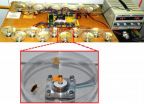(Press-News.org) To speed up reproduction, there's no substitute for the tender touch of a live cockroach.
That's the major takeaway from a North Carolina State University study examining whether artificial antennae – in this case, duck feathers – can mimic a cockroach antenna's capacity to hasten reproduction in cockroach females.
Female cockroaches that get "touched" – by other female cockroaches and, under certain conditions, even by duck feathers that mimic roach antennae – reproduce faster than female roaches that live in isolation or without tactile stimulation.
Pairing two cockroaches together – even roaches of different species – speeds up reproduction the most.
"To understand the mechanisms behind tactile stimulation and reproduction, we devised a motor-driven system using duck feathers as stand-ins for cockroach antennae. We found that these artificial antennae worked to stimulate certain hormones that speed up reproduction in the female German cockroach," says Dr. Coby Schal, Blanton J. Whitmire Professor of Entomology at NC State and the senior author of a paper describing the research. "We also found that the shape of the artificial antenna doing the 'touching' and the speed and duration of the stimulation were key factors that influenced reproduction speed."
Female cockroaches gain the capacity to produce eggs when they become adults, so reproduction speed can be described as the duration of time between the onset of adulthood and the first bout of egg-laying. Stimulating juvenile hormone production in adult female cockroaches accelerates growth of their eggs. When the eggs grow to a certain size, female cockroaches lay the eggs. Faster egg growth, therefore, translates into faster egg-laying. Differences between speedy reproduction and slower reproduction could be several days. And speedy reproduction leads to bigger infestations.
To elucidate the role that tactile sensation plays in reproduction, the researchers, led by first author Adrienn Uzsak, a former Ph.D. student in Schal's lab, performed a number of experiments. Throughout all the experiments, the researchers showed that isolating female roaches, or exposing them to dead roaches, slowed the reproductive process.
Isolating a female cockroach in a Petri dish while allowing another cockroach's antennae to protrude into the dish sped up reproduction greatly, but cutting the interloper's antennae down to nubs stifled reproduction speed to that of roaches in isolation.
The researchers also developed a motorized chamber that rotated a duck feather inside a Petri dish to act as a surrogate roach antenna. The researchers changed both the speed of the rotating feather and the duration of stimulation. Short bursts of stimulation with slow motor speeds led to faster reproduction, while longer stimulation bouts with a fast-moving feather slowed reproduction.
Finally, the researchers used different types of duck feathers in the motorized chamber, contrasting longer, barbed feathers with shorter, unbarbed feathers. Longer, barbed feathers stimulated faster reproduction.
"In studies over the years, we've learned how challenging it is to pinpoint the role of tactile stimulation in reproduction, although we knew from the start that it was important," Schal said. "Now we've learned that, under the right conditions, artificial antennae – including some that are quite different from cockroach antennae – can speed up reproduction, clarifying the importance of antennal contact and the role of antennal movement. Now that we have an experimental approach for consistent tactile stimulation, our next challenge is to understand how these stimuli cause females to produce more of the hormone that accelerates reproduction."
INFORMATION:
The study appears online in Proceedings of the Royal Society B. James Dieffenderfer and Dr. Alper Bozkurt, form NC State's Department of Electrical and Computer Engineering, co-authored the paper. Funding from the U.S. Department of Agriculture, the National Science Foundation and the Blanton J. Whitmire endowment powered the work.
- kulikowski -
Note to editors: An abstract of the paper follows.
"Social facilitation of insect reproduction with motor-driven tactile stimuli"
Authors: Adrienn Uzsak, James Dieffenderfer, Alper Bozkurt and Coby Schal, North Carolina State University
Published: Online April 1, 2014, in Proceedings of the Royal Society B DOI: 10.1098/rspb2014.0325
Abstract: Tactile stimuli provide animals with important information about the environment, including physical features such as obstacles, and biologically relevant cues related to food, mates, hosts and predators. The antennae, the principal sensory organs of insects, house an array of sensory receptors for olfaction, gustation, audition, nociception, balance, stability, graviception, static electric fields, and thermo-, hygro- and mechanoreception. The antennae, being the anteriormost sensory appendages, play a prominent role in social interactions with conspecifics that involve primarily chemosensory and tactile stimuli. In the German cockroach (Blattella germanica) antennal contact during social interactions modulates brain-regulated juvenile hormone production, ultimately accelerating the reproductive rate in females. The primary sensory modality mediating this social facilitation of reproduction is antennal mechanoreception. We investigated the key elements, or stimulus features, of antennal contact that socially facilitate reproduction in B. germanica females. Using motor-driven antenna mimics, we assessed the physiological responses of females to artificial tactile stimulation. Our results indicate that tactile stimulation with artificial materials, some deviating significantly from the native antennal morphology, can facilitate female reproduction. However, none of the artificial stimuli matched the effects of social interactions with a conspecific female.
'Touched' female cockroaches reproduce faster
2014-04-02
ELSE PRESS RELEASES FROM THIS DATE:
Ancient nomads spread earliest domestic grains along Silk Road, study finds
2014-04-02
Charred grains of barley, millet and wheat deposited nearly 5,000 years ago at campsites in the high plains of Kazakhstan show that nomadic sheepherders played a surprisingly important role in the early spread of domesticated crops throughout a mountainous east-west corridor along the historic Silk Road, suggests new research from Washington University in St. Louis.
"Our findings indicate that ancient nomadic pastoralists were key players in an east-west network that linked innovations and commodities between present-day China and southwest Asia," said study co-author ...
Unvaccinated infants act as 'kindling' to fuel epidemics
2014-04-02
ANN ARBOR—Nearly 4 million children under 5 die from vaccine-preventable diseases worldwide each year, and two University of Michigan doctoral ecology students are working to change that.
By taking into account seasonal fluctuations in birth rates, massive vaccination campaigns in the developing world could inoculate more unprotected infants and significantly reduce the number of deaths from diseases like measles, according to Micaela Martinez-Bakker and Kevin Bakker of the U-M Department of Ecology and Evolutionary Biology.
"If you have lots of kindling, you can have ...
Care of heart failure patients falling short in the UK
2014-04-02
Care of patients with heart failure in the UK is inadequate and has not changed in a decade, according to new research published in BMJ Open.
The findings by a team at Durham University and Darlington Memorial Hospital - and funded by national charity Heart Research UK - highlight inadequacies in heart failure care as well as an uncoordinated approach to diagnosis and management of the condition between primary and secondary care clinicians.
The research showed that clinicians are uncertain about how to diagnose different types of heart failure and about who has overall ...
Warm North Atlantic Ocean promotes extreme winters in US and Europe
2014-04-02
The extreme cold weather observed across Europe and the east coast of the US in recent winters could be partly down to natural, long-term variations in sea surface temperatures, according to a new study published today.
Researchers from the University of California Irvine have shown that a phenomenon known as the Atlantic Multidecadal Oscillation (AMO)—a natural pattern of variation in North Atlantic sea surface temperatures that switches between a positive and negative phase every 60-70 years—can affect an atmospheric circulation pattern, known as the North Atlantic ...
Not so dirty: Methane fuels life in pristine chalk rivers
2014-04-02
Scientists from Queen Mary University of London have found that naturally high concentrations of the greenhouse gas methane contributes to energy production in chalk rivers, in a new study published today in the journal Proceedings of the Royal Society B.
Chalk rivers, found from Dorset to Cambridgeshire, sustain a diverse range of protected animals and plants, and are renowned globally for fly fishing, an industry worth more than £4M on the Rivers Test and Itchen (Hampshire) alone.
"It's a surprise to find methane is such a big source of energy in these gin-clear ...
Male extinction prevented by promiscuous females
2014-04-02
LIVERPOOL, UK – 2 April 2014: Female fruit flies with a large number of sexual partners are playing an invaluable role in preventing the extinction of males, research at the University of Liverpool has shown.
Scientists have found that flies in the northern parts of the United States are more inclined to have multiple partners in order to reduce the occurrence of an X chromosome which causes the production of only female offspring.
This selfish genetic element (SGE) tries to replicate itself by killing sperm that carry the Y chromosome, but has the side-effect that ...
Still no clear evidence for health benefits of vitamin D
2014-04-02
They argue that "universal conclusions about its benefits cannot be drawn" and say further studies and better designed trials are needed.
A growing body of evidence indicates that vitamin D may reduce risks of a wide range of diseases, including bone mineral disease, multiple sclerosis, autoimmune disorders, cancer and cardiovascular problems. Yet, despite hundreds of trials, the evidence for vitamin D is still being debated.
Two papers published on bmj.com today attempt to make sense of the existing data.
The first, by researchers based in the UK, Europe and USA, ...
Probiotics do not help infants with colic
2014-04-02
These findings differ from previous smaller trials and do not support a general recommendation for the use of probiotics to treat colic in infants.
Infant colic (excessive crying of unknown cause) affects up to 20% of infants and is a major burden to families and health services. Although it spontaneously resolves three to four months after birth, its cause remains elusive and no single effective treatment exists.
Previous small trials suggest that the probiotic Lactobacillus reuteri effectively treats colic in breastfed infants. These studies, however, had limitations ...
New dementia diagnosis targets will lead to overdiagnosis
2014-04-02
The government is putting pressure on commissioners, and in turn general practitioners, to make more diagnoses of dementia, but no analysis has been done to assess the harm that these targets could cause.
Dr Martin Brunet, a GP from Surrey, says that "medicine depends on a fundamental, unspoken agreement between patients and doctors […] the only factor influencing the decision to diagnose should be the best interests of patients". He adds that the idea of doctors being motivated by self interest is "abhorrent and undermines the basis of the relationship".
He says that ...
The Sun's campaign may actually harm women
2014-04-02
The "check 'em Tuesday" campaign is a weekly call for women to examine their breasts. Readers are asked to send in photos to prove compliance and can even sign up for a text message reminder.
But Dr McCartney argues that teaching women to examine their breasts regularly "has been shown not to reduce deaths from breast cancer and actually increases the chances of a benign biopsy result." She says it is "unfair to tell women that regular self examination will save their lives when it may simply incur anxiety and have the potential to harm."
She points out that this is ...


